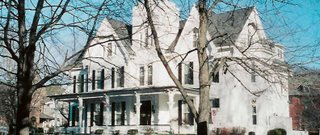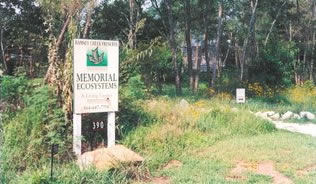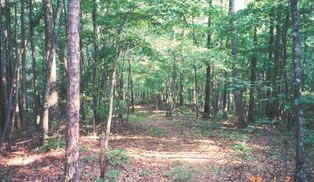Wednesday, December 20, 2006New York State's First Natural CemeteryAt the end of May, I spoke at the dedication of the Greensprings Natural Cemetery Preserve. The fifth natural cemetery in this country, Greensprings takes root on 100 acres of rolling meadowland that adjoins thousands of additional acres of protected forest just outside Ithaca, New York. Like its inspiration, Ramsey Creek, Greensprings offers the best of natural return: a green burial (vaultless and embalming-free) in a green setting, with plans to use the woodland cemetery scheme to not only protect this bucolic site from development but to restore it to ecological health. At the dedication, I spoke with Michael d'Estries, managing editor of GroovyGreen.com, a vibrant web outlet for environmental issues. The video he shot that day -- above -- offers a compelling, inside look at the genesis of Greensprings and the growing green burial movement it's giving rise to. For more information on Greensprings, visit the group's web site: www.naturalburial.org I'm on vacation through next week, back with a post on January 3rd. Happy holidays! Wednesday, December 13, 2006Natural Burial via the Local Funeral Home The modern funeral can't help but work at cross-purposes with the aims of natural burial. Chemical embalming of the dead, metal caskets sealed against the elements, the burial vaults that serve, in the words of one manufacturer, "as a last line of defense against mother nature," all seek to preserve the body from the dissolution that's a natural part of the life cycle -- and from the very goal of natural return. So, don't expect the local funeral director to cheer your request for a green burial. Particularly, as it represents the lost sale of the very goods and services that provide such a boost to his bottom line. But that may soon change. A handful of funeral directors around the country, recognizing that there are still profits to be gained by giving families what they want, are adding green burial options to their General Price List of offerings. One of them is Steve McCowen. A licensed funeral director based in Michigan and manager of a family-friendly funeral planning organization called the Today Center (www.todaycenter.com), McCowen works with sixteen funeral homes in the state that give families just what they ask for -- and no more -- hassle-free. "We'll pick the body up from the place of death, and bring it wherever the family wants, including their home, for home funerals," says McCowen. "They can even file the death certificate on their own." Families can skip embalming and choose from a cloth-covered, pine or cardboard coffin. Cost of the basic package runs less than $4,000, roughly half as much as the standard sendoff. You can find other family- and eco-friendly funeral providers like McCowen by contacting the Green Burial Council (www.decentburial.org). A non-profit group that's working to advance the cause of natural burial in this country, the Council directs families to providers that offer the group's green "Burial Package," which prohibits vaults and formaldehyde-based embalming, and permits only biodegradable caskets. So far, the Council has approved providers in seven states: California, Illinois, Indiana, Iowa, Missouri, New York and Wisconsin. For contact information, e-mail the Council at: info@greenburialcouncil.org. You don't have to work through the funeral home to arrange a natural burial, of course. In most cases, you can do it yourself. But for families that prefer the assistance of the local funeral parlor, the Council's burial package identifies those that understand the tenets of the eco-friendly burial -- and will help families arrange it. By making inroads into the funeral industry, the Council hopes over time to change it for the greener. The Burial Package is one small step in that direction. Still, as McCowen himself has found, the road is long. "I called the three-county area recently to find a cemetery that would allow one family to bury their dead without a vault, and couldn't find one," he says. In that case, McCowen arranged for the dead to be transported to a natural cemetery in another state. He has also successfully pursued another option that legally allows for vautless burial in Michigan: helping families designate a parcel of their rural property as a private burial ground. Wednesday, November 22, 2006Welcome to the Grave Matters Blog Natural Burial On a family trip back from the Georgia coast in the summer of 2003, I stopped off in the tiny town of Westminster, South Carolina (pop. 2,000), to see the Ramsey Creek Preserve for myself. Sitting in the shadow of the Blue Ridge Mountains, not far from the Georgia border, Ramsey Creek is the first -- and at that time only -- "natural" cemetery in the United States. On this thirty-plus acre woodland, heavily forested with mostly yellow and shortleaf pine, the dead are buried in simple graves, interred in either cloth shrouds or plain coffins made from cardboard or plentiful pine. Vaults are banned, embalming prohibited. The idea, so at odds with modern burial, is to allow the body to re-join the elements, to perpetuate the cycles of nature, to return dust to dust. I'd read about Ramsey Creek, and knew that some 200-plus similar woodland burial grounds were scattered throughout in the U.K. I'd come to South Carolina see if the reality matched what clearly on paper promised such a compelling alternative to the excessive, costly and tired sendoff on offer at the local funeral home.  For the better part of an afternoon, I walked the rough trail that cut through the memorial preserve, and afterwards talked with its founder, Billy Campbell -- the town doctor -- and his wife and business partner, Kimberley. By the time I got back to the Greenville hotel to collect my family, I felt sure Ramsey Creek represented not only a viable "green burial" option but one resonant enough to define a new, more truly natural American Way of death. I'd also walked into a book project. For the next two years, I traveled the country in pursuit of other burial options that, like interment at Ramsey Creek, returned remains to the elements, were sparing of resources and, thus, light on the pocketbook. The result of that effort is Grave Matters: A Journey Through the Modern Funeral Industry to a Natural Way of Burial, which Scribner will release on January 9th. I found, and reported on, a dozen families who opted out of the standard funeral experience in favor of more natural return. For some, that meant woodland burial, cremation and burial at sea, or interring the ashes of their loved ones in concrete "memorial reefs" that were later dropped into the Atlantic to serve as habitat for aquatic life. Still other families conducted home funerals and backyard burials; one hired a local carpenter to build a plain, pine coffin. By way of contrast, I wrote a pair of opening chapters that provide a step-by-step review of the embalming process and chart the potential environmental consequences that follow from standard burial. I had two goals. One, to inform families that they don't have to submit to the strictures of the modern funeral when death comes calling (i.e., embalming is almost never required). And, two, to offer a picture of the many more truly natural alternatives that exist and then show how to access them. I hope this blog will serve as a useful companion to the book. I'll use this space to report on developments in the field of natural burial, share ideas and engage in discussion. I welcome your participation. Mark Harris
Subscribe to:
Comments (Atom)
|
|||||||